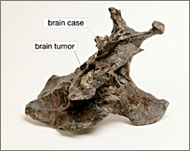Mammals ate dinosaurs
Scientists have discovered a 130-million-year-old fossil that indicates early mammals fed on young dinosaurs.

Found in northeast China, the fossil of a mammal with a baby dinosaur in its stomach dramatically alters the accepted view of the relationship between dinosaurs and early mammals.
Scientists at the American Museum of Natural History in New York unveiled the fossil on Wednesday.
The mammal was comparable in size and shape to a Tasmanian devil or a small dog, while the dinosaur was just a few inches long.
“The biggest surprise in this find is mammals eating dinosaurs,” said Meng Jin, associate curator in the division of palaeontology at the museum.
Startling find
“The importance of this discovery is that for the first time the stomach content of a mammal has been preserved and that a dinosaur is in it,” Meng added.
“Mammals now finally have the chance to speak up, because dinosaurs had been the only ones in the spotlight of the Mesozoic era.”
“Mammals now finally have the chance to speak up, because dinosaurs had been the only ones in the spotlight of the Mesozoic era” |
Most mammals of the Mesozoic era, between 144 and 65 million years ago, were the size of today’s mice and rats, weighing a few pounds at most and at a distinct size disadvantage compared to the dinosaurs.
But the latest discovery shows some mammals, the Repenomamus or “reptile mammals”, had a much greater range of body sizes than previously known, suggesting that some large mammals competed with dinosaurs for food and territory.
“This is the first ever discovery of this kind of material,” Meng said. “Mammals finally got the chance to taste dinosaurs. So that means that dinosaurs are edible, and maybe tasty.”
The Repenomamus had jaw muscles, and large, pointy teeth useful for catching and ripping prey, suggesting that these primitive mammals ate meat as well as plants and were aggressive predators, rather than scavengers.
Dream find
The baby dinosaur or psittacosaur found in this mammal fossil was 5in long – one-third the size of the animal that ate it. This kind of dinosaur, however, grew to the nearly 6ft tall and had four-fingered grasping hands.
 |
|
Scientists have also found brain |
he fossil was discovered about two years ago in rock composed of volcanic and former riverbed sediment where many well-preserved non-avian dinosaurs and bird fossils have been found in recent years.
Meng said the mammal had been poisoned by volcanic ash and had died peacefully “like a sleeping dog”.
For Meng, the discovery, published in the journal Nature, is close to what he first thought was his dream find: An embryo in a mammal.
Scientists do not have evidence of how primitive mammals reproduced, either by placenta or eggs, but Meng said: “My hope is to find a baby in a mammal, but we found a dino, which is also great.”